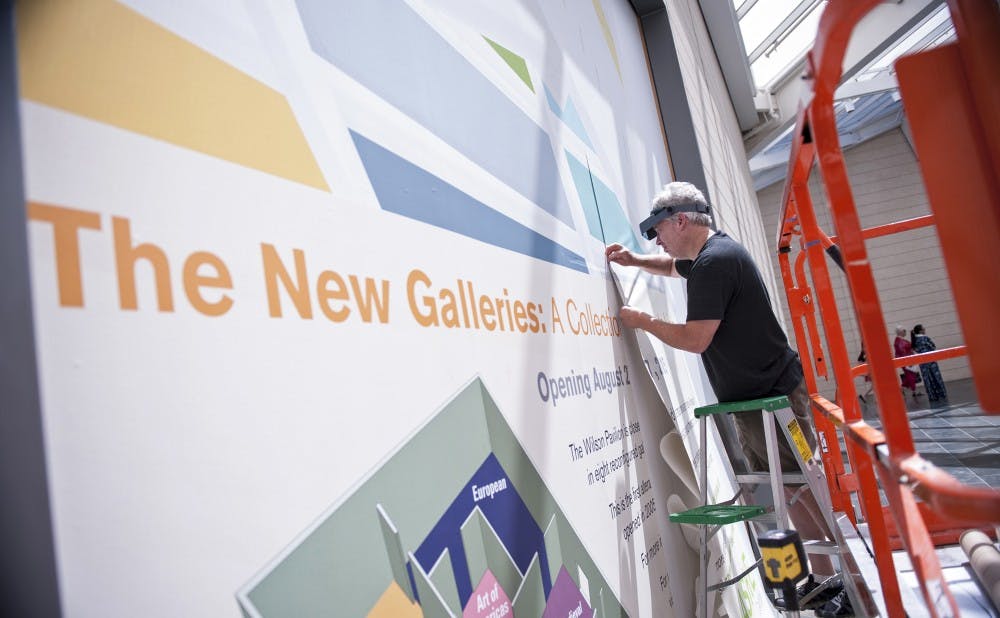From the outside, the Nasher Museum of Art looks not unlike an iceberg with its white, angular architecture. And also like an iceberg, the majority of the museum's assets are only visible below the surface.
With about 12,000 works in the Nasher’s current collection, it is not surprising that not everything can be put on display at once. Currently, there are around 300 works that are actively displayed in the galleries, representing only a small portion of the art the Nasher actually possesses.
“The statistic that I generally hear in museums is that 5 to 10 percent of any museum’s collection is on view,” said Marianne Wardle, the Andrew W. Mellon curator of academic programs at the Nasher.
Comprised now mostly of gifts but also a few museum purchases, Duke’s art collection was started in 1966 with the acquisition of the Ernest Brummer Collection, containing mostly medieval pieces. The art was moved into the basement of the Chapel, where a graduate student was brought in to catalogue it all. Today, the collection has found its home in the now 10-year-old Nasher Museum building, with a small number of works kept off-site. Far from dusty and boxed-up, the collection storage area of the Nasher Museum of Art is open and exciting.
“We just doubled the number of works from our permanent collection that are out on view when we opened the newly renovated Wilson Pavilion,” said Erin Hanas, coordinator of academic programs.
With the new Wilson Pavilion and the current exhibition The New Galleries: A Collection Come to Light, more works from the Nasher’s permanent collection have been brought to the public’s attention. Ranging from works from ancient Egypt to European art from the last few centuries, the exhibition features the various areas of the collection, as well as its depth.
“Different curators went through and assessed works in the collection to highlight the best things that we have,” Hanas said.
In addition to viewing the parts of the collection that are displayed in the galleries, Duke students as well as the general public can easily access the collection in its on-site storage spaces. With a room for prints, a room for paintings and a room for objects like sculptures and pottery, the storage areas at the Nasher are welcoming and open. Each room has an area where groups can congregate to view and discuss works.
“When the museum was built, they built storage on purpose to have space to bring classes in. A lot of museums have storage, even on-site storage, but they don’t have any place where people can go into storage,” Wardle said.
With an open, collaborative space inside of storage, the Nasher provides an in-depth view of the collection that’s more personal than just walking through the galleries. People can get closer to the works, allowing them a more detailed viewing of the art.
“It’s very intimate. You see details you may not have seen before. It’s almost like a private interview with the art,” said Germain Choffart, a lecturing fellow of French and a French cultural advisor, who took a group into collection storage last week to view French-themed works.
In order to give students a different view on their studies as well as to incite conversation about artistic and thematic elements of their academic subjects, the Nasher welcomes classes into storage to view works relating to material being covered in class.
“Italian classes come to look at Surrealism, for example,” Hanas said, “German classes come and look at German Expressionism.”
When a class or department signals their interest in seeing the collection, the professors work with Nasher staff to pick works that would be relevant yet interesting to students. The French group last week, for example, saw works by Degas, Manet and other French artists, and then discussed what exactly in each piece followed the French style.
"[The students] have to browse around and take notes, then turn that into something they apply, generally like an assignment or a class discussion," Choffart said. "It’s generally very well received by students because it’s a way to get out of class and do something different."
In addition to classes, Duke students and the public can contact Erin Hanas or Marianne Wardle to request to see a work in storage. A large amount of the collection is catalogued online, so students can browse what’s available for them to view before making an appointment.
Get The Chronicle straight to your inbox
Signup for our weekly newsletter. Cancel at any time.

